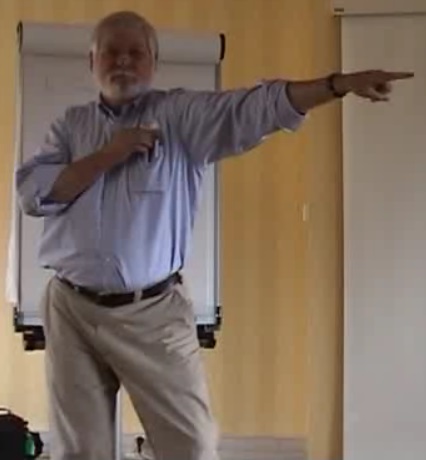
| Volume 33 #6 | May/June 2017 | |
This article is a report of a video I watched of a presentation by Bruce Hamilton at the 2009 Kaleidoscope Scottish Country Dance conference, titled, "A Novel Approach to Dealing with Mistakes".
 |
When someone makes a mental-slip mistake while dancing, the teacher often stops the music to correct the mistake. The dancer who made the mistake gets the message that correcting the mistake has a higher priority than the rest of the teacher's lesson plan, sufficient to cause everyone to stop dancing and stand.
From class to class, teacher to teacher, the message is, "Mistakes are really bad." The beginning dancer concludes: "I'm awkward. I can't do this stuff. It's not fun. I think I'll do something else." Or the dancer will keep coming but will dance timidly.
From the teacher's point of view, we want people to dance correctly. The teacher can compromise on the number and size of mistakes to correct. But the teacher can also become tentative in their teaching and become afraid of making mistakes with their students.
One approach is to set the expectation that mistakes will happen and focus on training to recover. For example, a beginning cross-country ski lesson instructor tells skiers, "Lie down in the snow. When you find yourself here, here's how you get up." Accept that mistakes are part of the fabric, and believe it. You can then think creatively and trust your actions. Making a lot of mistakes is part of Scottish Country Dancing. It's nothing to get excited about.
When you make a mistake:
1. Say "Darn!" (or your favorite one-syllable word) to yourself to stop yourself from thinking about what went wrong.
The brain wants to go into the past, but needs to look into the future.
2. Think, if I had done this properly, where would I be?
Many figures finish where they started, so we will often be okay if we don't do anything.
3. Go there and wait for the music to come around and join in.
Bruce spends a lot of time teaching this method. For example, part of teaching a new figure is: if this breaks, where will you go? This training conveys the message that the recovery is important, not the mistake. After dancers begin to acquire the recovery skill, Bruce begins to grade their recovery. If it's seamless and instantaneous, he shouts, "Gold star!" while pointing with a smile. If you recover within four bars, silver star. If you recover within eight bars, bronze star. If dancers keep wandering around, they hear the raspberry or some similar nonverbal communication. Dancers laugh and are relaxed when recovery is criticized, compared with becoming nervous when mistakes are criticized.
The results that Bruce has observed are: * He sees a lot more open faces. People take a new figure and dive in, moving boldly with faces outward instead of inward. * Dancers learn a useful skill, they know it and feel they are growing and want to come back. * This only works with beginners. Once you learn mistakes are bad, it takes years to unlearn. Once you learn to move tentatively, it can take years to unlearn the muscle memory. * It is challenging to teach this way. As the teacher gets better at believing that mistakes are okay, the students get better at acting like mistakes are okay.
This procedure is for mistakes that are mental slips. A related paper discusses mental slips and also a parallel procedure to deal with inaccurate or incomplete understanding. Bruce loves to chat about this if you're interested. You can write to him at (note no 'n').
We can view a video of the presentation at
https://video.strathspey.org/w/gDstEZ6Ea9WpP9hkz5ywrk
We can read the related paper at
http://www.rscds-swws.org/news/kscope1/mistakes-hamilton.htm
Bruce's recovery training procedure is consistent with the "growth mindset", compared with the "fixed mindset" that is a significant reason why over 95 percent of the public does no dancing of any kind. More about these mindsets in a future article.